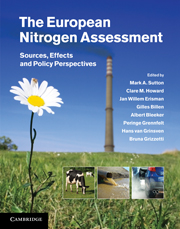Book contents
- Frontmatter
- Contents
- List of contributors
- Foreword
- Summary for policy makers
- Technical summary
- 1 Assessing our nitrogen inheritance
- Part I Nitrogen in Europe: the present position
- Part II Nitrogen processing in the biosphere
- 6 Nitrogen processes in terrestrial ecosystems
- 7 Nitrogen processes in aquatic ecosystems
- 8 Nitrogen processes in coastal and marine ecosystems
- 9 Nitrogen processes in the atmosphere
- Part III Nitrogen flows and fate at multiple spatial scales
- Part IV Managing nitrogen in relation to key societal threats
- Part V European nitrogen policies and future challenges
- Glossary
- Index
- References
9 - Nitrogen processes in the atmosphere
from Part II - Nitrogen processing in the biosphere
Published online by Cambridge University Press: 16 May 2011
- Frontmatter
- Contents
- List of contributors
- Foreword
- Summary for policy makers
- Technical summary
- 1 Assessing our nitrogen inheritance
- Part I Nitrogen in Europe: the present position
- Part II Nitrogen processing in the biosphere
- 6 Nitrogen processes in terrestrial ecosystems
- 7 Nitrogen processes in aquatic ecosystems
- 8 Nitrogen processes in coastal and marine ecosystems
- 9 Nitrogen processes in the atmosphere
- Part III Nitrogen flows and fate at multiple spatial scales
- Part IV Managing nitrogen in relation to key societal threats
- Part V European nitrogen policies and future challenges
- Glossary
- Index
- References
Summary
Executive summary
Nature of the problem
The two main groups of atmospheric reactive nitrogen compounds (reduced and oxidized nitrogen) have different fates due to differences in governing processes.
Abatement strategies need to take into account these differences when assessing the impact on the sensitive ecosystems.
Approaches
The chapter outlines the governing physical and chemical processes for the two main groups of reactive nitrogen compounds.
The chapter is divided into sections concerning: emissions, transformation, aerosol processes, dry deposition and wet deposition.
Key findings/state of knowledge
Reactive nitrogen compounds consist of reduced nitrogen (ammonia and its reaction product ammonium), oxidized nitrogen (nitrogen oxides) and organic nitrogen compounds.
Nitrogen oxides have little impact close to the sources since they are emitted as nitrogen monoxide and nitrogen dioxide with low dry deposition rates. These compounds need to be converted into nitric acid (about 5% per hour) before deposition is efficient.
Ammonia has a high impact near the sources due to high dry deposition rates. Ammonia may therefore have significant impact on ecosystems in areas with intense agricultural activity leading to high emissions of ammonia.
Both ammonia and gaseous nitrogen oxides lead to formation of aerosol phase compounds (ammonium and nitrate) which are transported over long distances (up to more than 1000 km).
Very little is known either quantitatively or qualitatively about organic nitrogen compounds, other than that they can contribute a significant fraction of wet-deposited N, and are present in gaseous and particulate forms in the atmosphere.
- Type
- Chapter
- Information
- The European Nitrogen AssessmentSources, Effects and Policy Perspectives, pp. 177 - 208Publisher: Cambridge University PressPrint publication year: 2011
References
- 28
- Cited by

